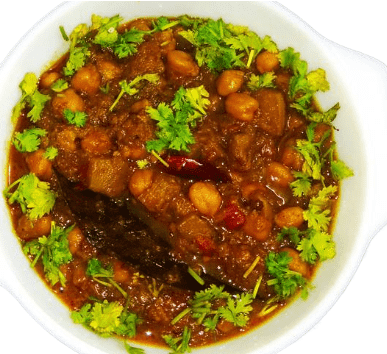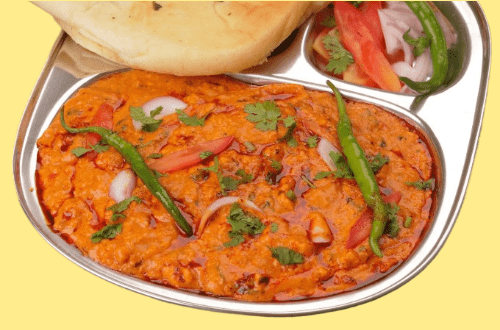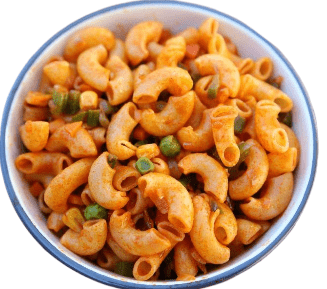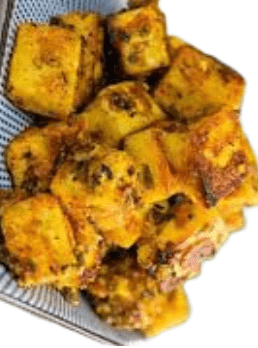Best Cooker Vegetarian Curry
Introduction Of Cooker Vegetarian Curry:
Cooker Vegetarian Curry is There’s something truly magical about coming home to the aroma of a warm, fragrant curry simmering away in your slow cooker. Whether you’re a seasoned curry enthusiast or a newbie to the world of slow cooker meals, this Slow Cooker Vegetarian Curry is about to become a game-changer in your kitchen. This recipe is perfect for busy days when you want a hearty, nutritious meal without hovering over the stove.
Why Vegetarian Curry? Not only is this dish a comforting and delicious way to enjoy a variety of vegetables, but it’s also incredibly healthy. Vegetarian curries are rich in fiber, vitamins, and plant-based proteins, making them a perfect meal for those looking to eat healthier or explore more plant-based dishes. Plus, they’re incredibly versatile—swap the vegetables, change up the spices, and make it your own.
The Unique Twist: In this recipe, we add a special twist with the addition of roasted sweet potatoes and a blend of unexpected spices, giving the curry a sweet, smoky flavor that sets it apart from traditional versions. We’ll also explore the use of unique ingredients like tamarind for a tangy kick and coconut milk for a rich, creamy finish.
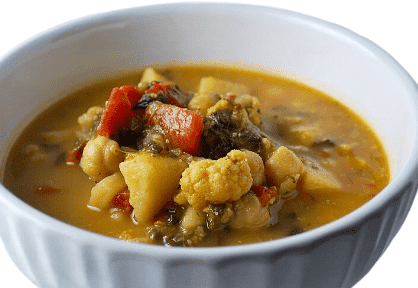
The Secret to a Perfect Slow Cooker Vegetarian Curry:
Slow cooking is an ideal way to make curry because it allows the flavors to develop over time, creating a depth that’s hard to achieve with quicker methods. By layering ingredients, starting with aromatics, and using fresh spices, you’ll end up with a curry that’s rich, complex, and deeply satisfying.
Ingredients Of Cooker Vegetarian Curry:
Here’s what you’ll need to create this delicious Slow Cooker Vegetarian Curry. Each ingredient plays a specific role in building layers of flavor, and substitutions are provided for versatility.
Base Ingredients:
- 2 tablespoons olive oil or coconut oil: Adds a rich mouthfeel and helps sauté the aromatics.
- 1 large onion, finely chopped: The backbone of the curry, providing sweetness and depth.
- 4 cloves garlic, minced: Essential for flavor—garlic adds a spicy, aromatic punch.
- 1-inch piece ginger, grated: Fresh ginger brings a zesty heat that complements the spices.
Vegetables:
- 2 medium carrots, diced: Adds sweetness and a bit of crunch.
- 2 sweet potatoes, peeled and cubed: Roasted before adding to the slow cooker for a caramelized, smoky flavor.
- 1 red bell pepper, sliced: Adds color and a slight sweetness.
- 1 zucchini, sliced into half-moons: For a tender texture that balances the firmer vegetables.
- 2 cups spinach or kale, roughly chopped: Added at the end for color, texture, and nutrients.
Protein:
- 1 can chickpeas, drained and rinsed: Provides protein and a creamy texture.
- ½ cup red lentils: Breaks down during cooking, thickening the curry and adding richness.
Spices and Seasoning:
- 2 tablespoons curry powder (homemade or store-bought): The main flavor profile—choose a blend that suits your taste.
- 1 teaspoon garam masala: Adds warmth and complexity, typically added towards the end of cooking.
- 1 teaspoon cumin seeds: Toasted for a nutty, earthy undertone.
- ½ teaspoon turmeric: For color and a subtle peppery flavor.
- 1 teaspoon smoked paprika: This is the secret to adding a smoky, deep flavor.
- 1 teaspoon ground coriander: Complements the other spices with a light, citrusy note.
- Salt and pepper to taste: Adjust to balance the flavors.
Liquids:
- 1 can (14 oz) full-fat coconut milk: For creaminess and a hint of sweetness.
- 2 cups vegetable broth: Helps cook the lentils and adds depth.
- 2 tablespoons tomato paste or 1 cup diced tomatoes: Adds acidity and richness.
Optional Add-ins:
- 2 tablespoons tamarind paste: For a tangy, slightly sweet flavor that brightens the curry.
- Juice of 1 lime or lemon: Adds acidity and balances the richness.
- Fresh cilantro or parsley, chopped: For garnish, adding a fresh, herbaceous note.
- Chopped nuts or seeds (like almonds or sesame seeds): Adds texture and a bit of crunch as a garnish.
Step-by-Step Cooking Instructions Of Cooker Vegetarian Curry:
Preparing the Vegetables and Spices For Cooker Vegetarian Curry:
Prepping the Vegetables:
- Chop the vegetables: Dice the carrots, peel and cube the sweet potatoes, slice the bell pepper, and cut the zucchini into half-moons. The uniform size ensures even cooking.
- Roast the sweet potatoes: Preheat your oven to 400°F (200°C). Hurl the cubed sweet potatoes with a tablespoon of olive oil, salt, and pepper. Spread them out on a baking sheet and roast for 20-25 minutes until they are golden and slightly caramelized. This step enhances their sweetness and adds a smoky layer to the curry.
Preparing the Aromatics:
- Chop the aromatics: Finely chop the onion, mince the garlic, and grind the ginger. These form the flavor base of your curry.
- Toast the spices: In a small dry skillet, toast the cumin seeds over medium heat for about 2 minutes, until fragrant. This releases their oils and intensifies their flavor.
Layering the Curry in the Cooker Vegetarian Curry:
Sautéing the Aromatics:
- Sauté the onions: Heat the remaining olive oil in a skillet over medium heat. Include the chopped onion and cook until delicate and translucent, around 5 minutes.
- Include garlic and ginger: Blend in the minced garlic and ground ginger, cooking for another 1-2 minutes until fragrant.
- Add spices: Stir in the curry powder, smoked paprika, turmeric, and ground coriander. Cook the spices for a minute to bloom their flavors, then add the tomato paste. Stir well until everything is combined.
Layering in the Slow Cooker:
- Add sautéed aromatics: Transfer the aromatic mixture to your slow cooker.
- Add vegetables and chickpeas: Layer the roasted sweet potatoes, carrots, bell pepper, zucchini, and chickpeas on top.
- Add lentils: Sprinkle the red lentils over the vegetables. They will thicken the curry as they cook.
- Pour in liquids: Add the coconut milk and vegetable broth, stirring to combine everything. This liquid will simmer the vegetables and infuse them with flavor.
Slow Cooking Of Cooker Vegetarian Curry:
Cooking Settings:
- Set the slow cooker: Cover and set your slow cooker to low for 6-8 hours or high for 3-4 hours. Cooking on moo will permit the flavors to merge delightfully.
- Stir occasionally: If possible, give the curry a gentle stir halfway through cooking to ensure the lentils don’t stick to the bottom.
Finishing Touches:
- Add greens: About 15 minutes before serving, stir in the chopped spinach or kale. They will wilt in the residual heat, adding a vibrant green color.
- Adjust seasonings: Taste the curry and adjust the salt, pepper, and spices as needed. If you’re adding tamarind paste or lime juice, stir it in now for a final burst of flavor.
Unique Twists and Variations Of Cooker Vegetarian Curry:
One of the best things about this Slow Cooker Vegetarian Curry is its versatility. Here are some unique twists to customize the recipe according to your preferences or dietary needs:
Flavor Variations:
- Add Fruit for a Sweet Note: Incorporate fruits like diced pineapple, mango, or apple for a subtle sweetness that pairs well with the spices.
- Swap Proteins: Substitute chickpeas with tofu, paneer, or even tempeh for a different texture and protein boost.
- Play with Spices: Experiment with different spice blends like Thai red curry paste for a Southeast Asian twist, or add curry leaves and mustard seeds for a South Indian flavor.
Regional Adaptations
- Thai-Inspired Curry: Add lemongrass, kaffir lime leaves, and a spoonful of Thai red curry paste for a tangy, fragrant twist.
- Caribbean Curry: Incorporate allspice, Scotch bonnet peppers, and thyme to bring out the flavors of Caribbean curries.
Dietary Adjustments:
- Gluten-Free and Nut-Free Options: Ensure all spice blends are gluten-free, and omit any nuts used as a garnish.
- Low-Carb Version: Replace starchy vegetables like sweet potatoes with lower-carb options like cauliflower or broccoli.
Adjusting Spice Levels:
- Milder Curry: Reduce the amount of curry powder and smoked paprika, and opt for a sweeter coconut milk.
- Spicier Curry: Add a finely chopped chili pepper or a dash of cayenne pepper for more heat.
Serving Suggestions Of Cooker Vegetarian Curry:
This curry is hearty enough to be enjoyed on its own, but it truly shines when paired with complementary sides.
Perfect Sides for Your Curry:
- Steamed Basmati Rice or Quinoa: The fluffy grains soak up the curry sauce beautifully.
- Warm Naan or Roti: Perfect for scooping up the curry, making every bite flavorful.
- Cucumber Raita: A cooling yogurt-based side with cucumbers, mint, and cumin that balances the spices in the curry.
Presentation Tips Of Cooker Vegetarian Curry:
- Garnish Well: Top the curry with fresh cilantro, a squeeze of lime, and a sprinkle of toasted seeds or nuts for extra texture.
- Serve in Vibrant Bowls: Bright, colorful bowls enhance the visual appeal, making the dish look as good as it tastes.
Storage and Meal Prep Tips Of Cooker Vegetarian Curry:
Storing Leftovers:
- Refrigerate: Store leftover curry in an airtight container in the fridge for up to 4 days. The flavors will proceed to create, making it indeed more tasty.
- Freeze: Freeze the curry in portions for up to 3 months. Thaw overnight in the fridge and reheat gently on the stovetop or microwave.
Reheating Tips:
- On the Stovetop: Reheat over medium heat, stirring occasionally. Add a splash of vegetable broth or water if the curry has thickened too much.
- In the Microwave: Heat in a microwave-safe bowl, stirring every minute until warmed through.
Meal Prep Ideas:
- Batch Cooking: Double the recipe and freeze half for future meals. Perfect for busy weeks when you need something nutritious and quick.
- Creative Leftovers: Use the curry as a filling for wraps, or stuff it into baked sweet potatoes for a unique twist.
Nutritional Information and Health Benefits For Cooker Vegetarian Curry:
This curry is not just comforting—it’s packed with nutrients that support a healthy lifestyle.
Health Benefits Of Cooker Vegetarian Curry:
- High in Fiber: Thanks to the variety of vegetables and chickpeas, this curry is excellent for digestive health.
- Rich in Plant-Based Protein: Lentils and chickpeas provide protein, essential for muscle repair and overall health.
- Loaded with Vitamins and Antioxidants: Vegetables like sweet potatoes, bell peppers, and leafy greens are packed with vitamins A, C, and K.
Nutritional Breakdown (per serving):
- Calories: Approximately 300
- Protein: 10g
- Carbohydrates: 40g
- Fiber: 8g
- Fat: 12g
Tips for Success Of Cooker Vegetarian Curry:
Creating a perfect slow cooker curry is all about balancing flavors and textures. Here are some tips to ensure your curry turns out great every time.
Common Mistakes and How to Avoid Them:
- Overcooking Vegetables: Add sturdier vegetables like carrots early, but more delicate ones like bell peppers and zucchini should be added later if possible.
- Thickening the Curry: If your curry is too thin, let it cook uncovered for the last 30 minutes, or stir in a cornstarch slurry.
Expert Tips For Cooker Vegetarian Curry:
- Use Fresh Spices: Old spices lose their potency. For the best flavor, buy spices in small quantities and replace them every 6 months.
- Customize the Heat: If you’re unsure about spice levels, start with less and add more gradually. You can always add heat, but it’s hard to take it away!
Frequently Asked Questions
- Can I make this curry ahead of time?
- Yes, this curry tastes even better the next day as the flavors continue to meld. It’s perfect for meal prep.
- Can I use frozen vegetables?
- Absolutely! Frozen vegetables are a great timesaver. Just add them directly to the slow cooker—no need to thaw.
- What other vegetables can I add?
- Feel free to add anything you have on hand, like cauliflower, peas, or green beans. Just adjust the cooking time if needed.
- Can I make this curry in an Instant Pot?
- Yes, you can! Use the sauté function for the aromatics, then pressure cook on high for about 8 minutes. Let the pressure release naturally for a few minutes before serving.
Read More: Aloo ki Vrat Wali Sabji
Conclusion Of Cooker Vegetarian Curry:
There you have it—a rich, comforting Slow Cooker Vegetarian Curry that’s bursting with flavor and packed with nutrients. Whether you’re serving it for a cozy family dinner or prepping it for easy weekday meals, this recipe is sure to become a staple in your home.
Try it out and make it your own! Share your twists, and don’t forget to tag us on social media. If you loved this recipe, subscribe to our blog for more unique and delicious vegetarian dishes.
